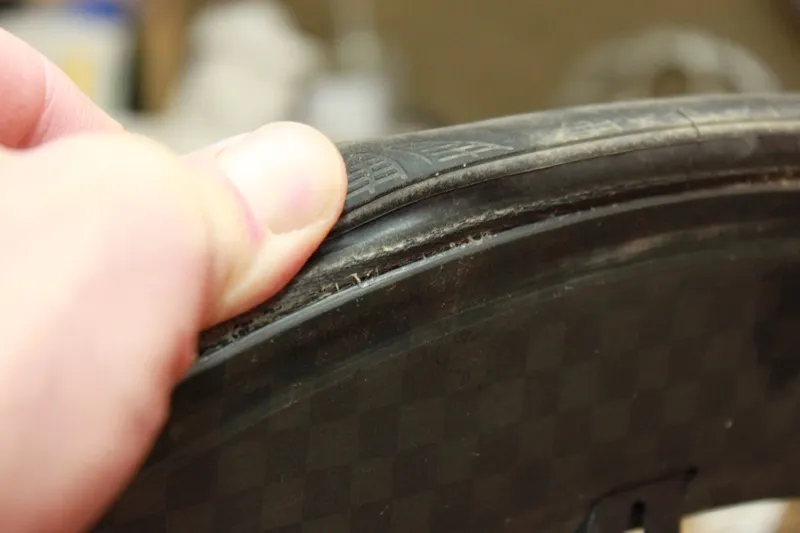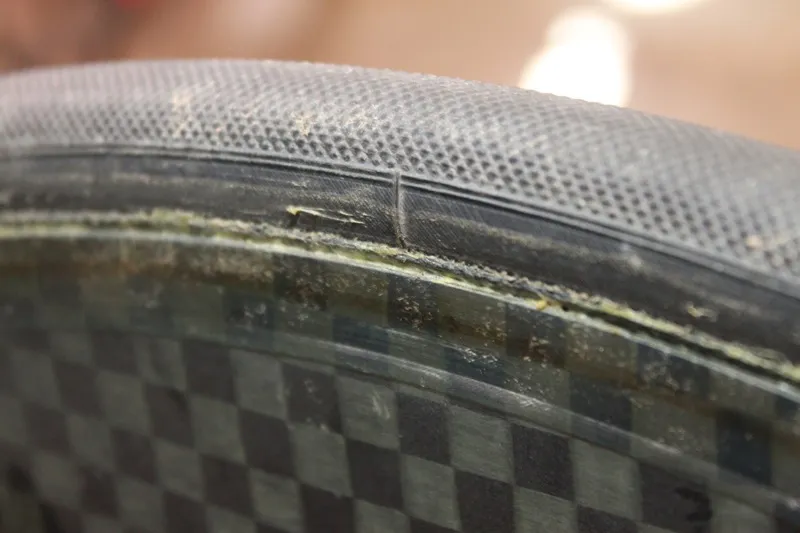The concept of the tubular system — gluing a tire to a rim — is more than 100 years old and dates back to a time when racing rims were made of wood. Things have progressed since then, with Mavic racing the first alloy tubular rim, called ‘Dura’, in 1934, and carbon fibre infiltrating in the 1990s.
For the past five years it's carbon that has proliferated but it was only in 2009 that Continental introduced the first glue specifically designed for carbon tubular rims. It was worth the wait, though, because we can highly recommend the new Carbon Rim Cement. It provides excellent adhesion with the benefit of fewer installation steps than standard glue.
How it works
Aside from the initial issues with gluing a tire to carbon – namely, getting a surface that’s free of carbon mold release agents – the main problem with the material is its relatively low heat capacity. Carbon rims tend to heat up quickly and run hotter than alloy ones. On long mountain descents this can create a scenario in which the tubular glue heats up and loses its adhesive properties, greatly increasing the chances of rolling a tire.
In third party testing, by the time a rim is too hot to touch, Continental’s standard glue has lost 50 percent of its adhesive strength (Chip Howat: Tubular Tires: Adhesives and Practice. (Part 6)). The new carbon-specific glue, however, is formulated with a higher resistance to heat. Continental claim a bond that's three times stronger than their standard glue at 70C (158F).
The one issue with the new glue, according to Continental, is that it can't be applied using a traditional layering technique. The adhesive goes on thicker, and Continental say it will not dry if too much is applied to either the rim or tire. This is bad news if a mechanic ignores Continental’s application instructions, because this can lead to failure.
But it's good news if the instructions are followed, as the procedure only takes two steps (once the rim is clean) to form an exceptional bond between tire and rim. The proper procedure is as follows: clean the rim and tire; apply one thin layer of glue to the rim and tire (though it’s not possible to apply a layer as thin as it is with standard glue); let dry for eight to 24 hours; apply one thin layer of glue to the tire, mount it; wait 24 hours to ride the wheel.
Chip Howat, a professor at the University of Kansas, is the foremost expert on tubular gluing and adhesion. He has literally written the book on proper installation techniques and ranked the performance of the bike industry’s tubular adhesives. We were the first to talk to Howat about Continental’s new glue, which after testing he recommends for use with carbon tubular rims.

Our tires are solid, and Howat's third-party research says that the new glue is 20 percent stronger than Conti's standard glue
“It did well,” said Howat. “I did four separate tests: one with [Vittoria] Mastik One, one with conventional Continental glue, one with the carbon glue following the manufacturer's recommendations and then one using the carbon glue and my procedure [three light layers of glue on the rim, one on the tire]. Using my gluing procedure against the standard [Continental] glue, it looks like 20 to 25 percent better. [With their procedure] it’s still good, better than conventional, but only marginally so.” Howat hasn't yet tested the new glue’s heat resistance.
Howat’s method for gluing is a process that one of his students earned his master’s degree testing. “We tested every procedure that we knew was out there and then developed our own,” said Howat. “We found that multiple layers on the tire — now these were all conventional glues, before the carbon glue came out — didn’t make a difference; one coat was sufficient. What really made a difference are multiple coats on the rim. We tested one coat, two coats, three coats, four and five coats, and we found that diminishing returns set in after three coats."
“It’s probably not as easy to put on,” Howat said when asked for summary of the Continental carbon glue. “It’s a thicker carrier and solvent, so I found that it was more difficult to get a uniform coat. But obviously it’s performing better… so I'd use it, if it were available to me.”
(Note: Howat tested the new Continental glue at the request of the brand’s American distributors, who provided the glue and test tires free of charge. However, Howat bought his own tires and standard glues to test against and was otherwise not paid or compensated for the test.)
Continental’s Carbon Rim Cement is available in 25g tubes for US$5 and 200g brush-quipped cans for $44.95. Using Continental’s application instructions, each 25g tube of glue is adequate for the installation of one tire.


